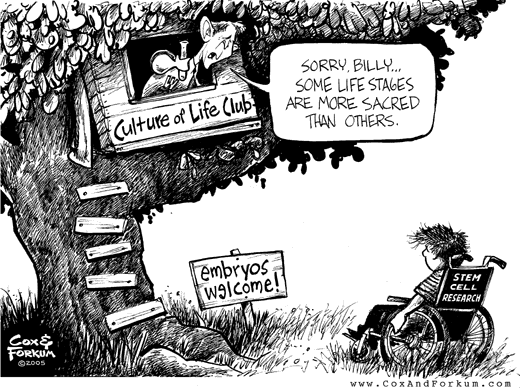Recent research has shown that there are four other potential ways of obtaining embryonic stem cells without destroying a human embryo, making these options hopefully less controversial.
The first is called the Parthenote Proposal. This is the idea of creating a parthenote which is an egg, triggered by chemicals to think it has been fertilized and begin dividing and organizing, that develops into an embryo producing embryonic stem cells. Eggs that have not been fertilized can be used. These eggs can easily be found due to the fact that reproductive clinics throw away thousands of them which have failed to fertilize through IVF attempts. The ethical issue is minimized because human parthenotes cannot develop far in a natural state because of the lack of paternal DNA, many researchers consider them embryo-like entities but not embryos.
A second option is the Morula Proposal. This would involved scientists using an embryo that has developed to the 8-cell stage, called a morula, and remove a solo cell which could be coaxed to replicate into an embryonic stem cell line. The now 7-cell embryo can then be implanted into a womb and grow normally.
Next, a third option is an organ transplant proposal. Some scientists believe that just as there are people who are brain dead but have functioning organs, there are embryos that exist that are in essence dead in a similar way. When an embryo is believed to not be able to develop an farther the term "arrested development" is used.
Lastly, is the alternate nuclear transfer (ANT) proposal. ANT has similarities to cloning. Scientists would create an "embryo-like entity" which would not have the developmental gene making it similar to those that would develop into a cancerous tumor. Basically, a developmental gene is turned off in the nucleus being transferred. Then using the cloning process, the altered nucleus is then inserted into an enucleated egg, stimulated to divide, and stem cells can then be harvested.
However, just like traditional embryonic stem cell research, each of these methods have their own technical and ethical problems as well which can be seen at this site.
Friday, October 26, 2007
Subscribe to:
Post Comments (Atom)

5 comments:
I really enjoyed reading this post. You really seem to have done your research. You presented your thoughts in a clear and concise way that promotes understanding. I like how you presented alternate options to the issue at hand. I think it is important that people research the alternatives if the given method is proving so invalid (or in this case, controversial.) good work.
Thanks Fred, I appreciate your complement. Although some of technology is not yet developed for some of these alternatives, I have a feeling that it will come sooner than an acceptance in the traditional way of harvesting human embryonic stem cells.
I dont understand why this subject is really an issue then. If there is a way to research stem cells and not have to work on human embryos why not do it. Besides the last way you described that dealt with cloning I dont see people really opposing the issue as much. The other two ways were a lot less controversial. We should put more work into those two fields.
WOW really interesting stuff here! I never knew that there were embyronic stem cells that were still "alive" even when considered dead. But I'm still not sure how I feel about this whole ANT proposal or cloning thing. I mean I don't have a problem with it but I do know that the cloning suggestion is a big issue for many people especially those who are religious. So in your opinion, how do you think the ANT propospal will be accepted by the general public? or will it just considered another attempt at cloning?
Kristy - I agree that these new methods really have a chance of revolutionizing the way embryonic stem cell research is viewed; however, cloning is a whole other issue on its own. Do you think individuals would not be as concerned with cloning an embryo as they are about cloning humans? Although the technology is still being developed these options may be our long awaited middle ground in the debate.
Post a Comment